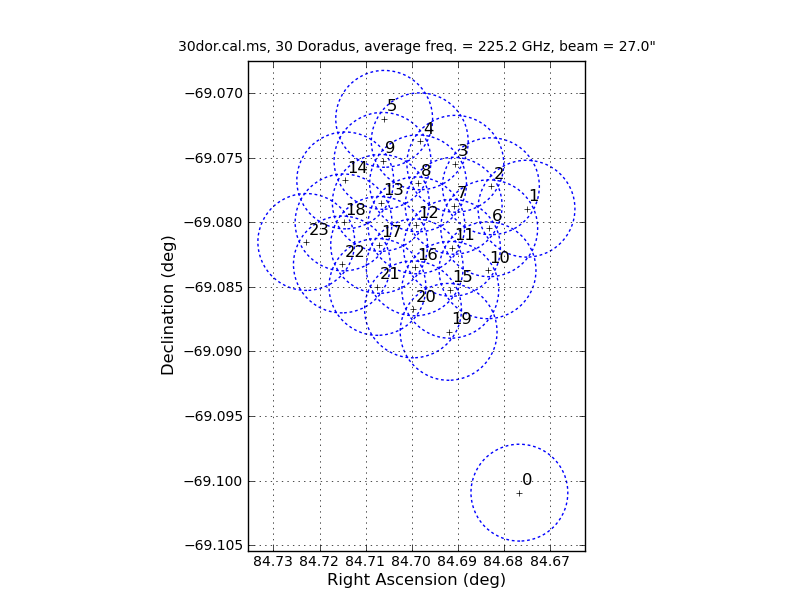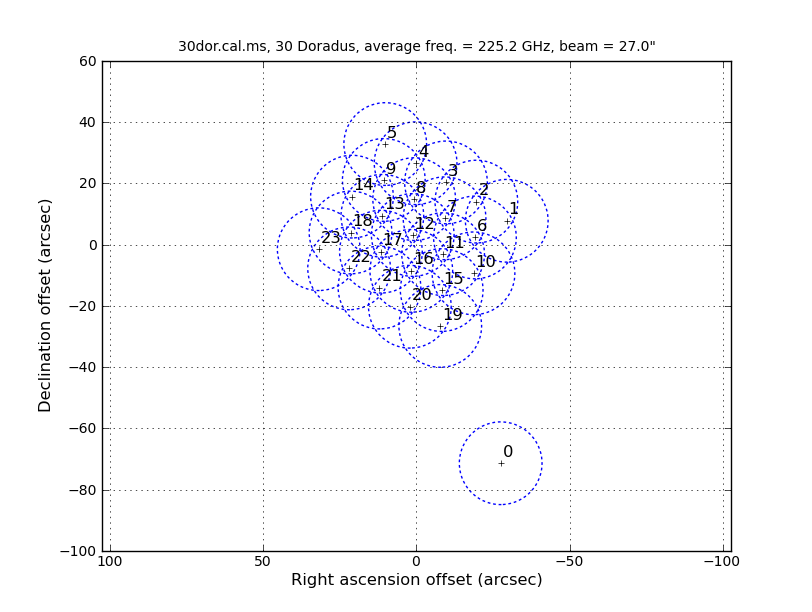Plotmosaic: Difference between revisions
From CASA Guides
Jump to navigationJump to search
No edit summary |
No edit summary |
||
| Line 16: | Line 16: | ||
* The title will include the visibility file name but with any parent directory removed. | * The title will include the visibility file name but with any parent directory removed. | ||
* If sciencespws=True, then run ValueMapping to determine science spws. | * If sciencespws=True, then run ValueMapping to determine science spws. | ||
* If vm is not | * If vm is not a blank string, then it's assumed to be a ValueMapping structure (only relevant for casa < 4.1) | ||
* The size of the circle plotted is 1.17*lambda/dish_diameter, which is correct for ALMA antennas | * The size of the circle plotted is 1.17*lambda/dish_diameter, which is correct for ALMA antennas | ||
Revision as of 16:54, 26 June 2013
Return to Analysis Utilities
This page documents the plotmosaic function of Python module analysisUtils.
This function produces a plot of the pointings in a MS with primary beam FWHM circles and field names overlaid. For a multi-source file, you can include the sourceid to limit the fields to the science target. The default coordinate system is 'relative'. You can also use 'absolute', in which case the RA and Dec are shown in decimal degrees. This could be improved to be HH:MM:SS if there is demand. (Note: plotmosaic and plotMosaic are synonyms.)
Usage:
au.plotmosaic(vis, sourceid=2, figfile='mosaic.png', coord='relative', skipsource=-1, doplot=True, help=False, sciencespws=False, vm=")
Notes:
- The sourceid may be either an integer, integer string, or the string name of the source (but it cannot be a list).
- If doplot=False, then the central field ID is returned as an integer. Otherwise, a list is returned which is useful for determining the required image size for clean: [centralField, maxRA, minRA, minDec, maxDec] where the angles are in units of arcsec relative to the center.
- If coord='absolute', then nothing is returned.
- figfile can be either a string or "True". In the latter case, the automatic name will be: [vis].pointings.[coord].png
- The title will include the visibility file name but with any parent directory removed.
- If sciencespws=True, then run ValueMapping to determine science spws.
- If vm is not a blank string, then it's assumed to be a ValueMapping structure (only relevant for casa < 4.1)
- The size of the circle plotted is 1.17*lambda/dish_diameter, which is correct for ALMA antennas
Examples
# In CASA
CASA <2>: au.plotMosaic("30dor.cal.ms",sourceid='30 Doradus',doplot=False)
Field IDs with matching source ID = [ 0 1 2 3 4 5 6 7 8 9 10 11 12 13 14 15 16 17 18 19 20 21 22 23] Got longitude = -67.755 deg Mean frequency = 225.180484 GHz Found 24 pointings Field 12 is closest to the center of the area covered (3.3 arcsec away). Out[18]: 12
# In CASA
CASA <3>: au.plotMosaic("30dor.cal.ms",sourceid='30 Doradus',coord='abs',figfile='/tmp/absolute.png')
Field IDs with matching source ID = [ 0 1 2 3 4 5 6 7 8 9 10 11 12 13 14 15 16 17 18 19 20 21 22 23] Got longitude = -67.755 deg Mean frequency = 225.180484 GHz Found 24 pointings Field 12 is closest to the center of the area covered (3.3 arcsec away). Wrote file = /tmp/absolute.png
# In CASA
CASA <4>: au.plotMosaic("30dor.cal.ms",sourceid='30 Doradus',coord='rel',figfile='/tmp/relative.png')
Field IDs with matching source ID = [ 0 1 2 3 4 5 6 7 8 9 10 11 12 13 14 15 16 17 18 19 20 21 22 23] Got longitude = -67.755 deg Mean frequency = 225.180484 GHz Found 24 pointings Field 12 is closest to the center of the area covered (3.3 arcsec away). Wrote file = /tmp/relative.png Out[4]: [12, 58.898348082265692, -56.505271415428538, 59.801877597487355, -98.429477166421918]

